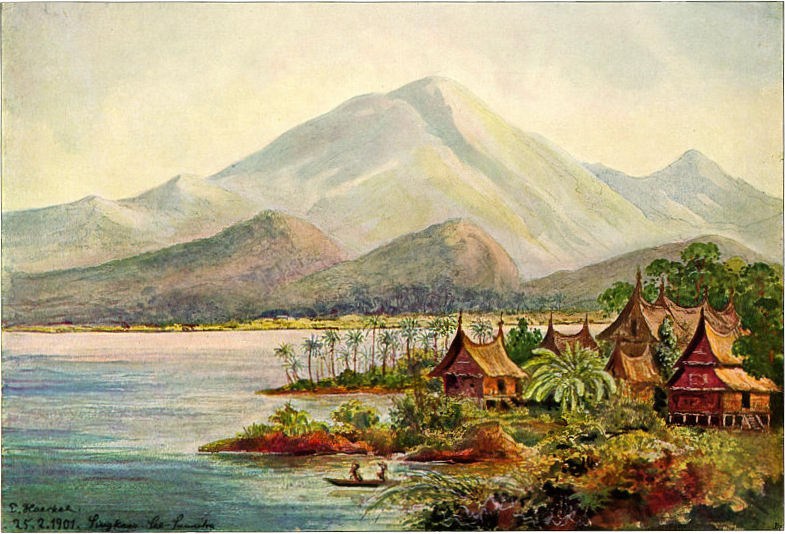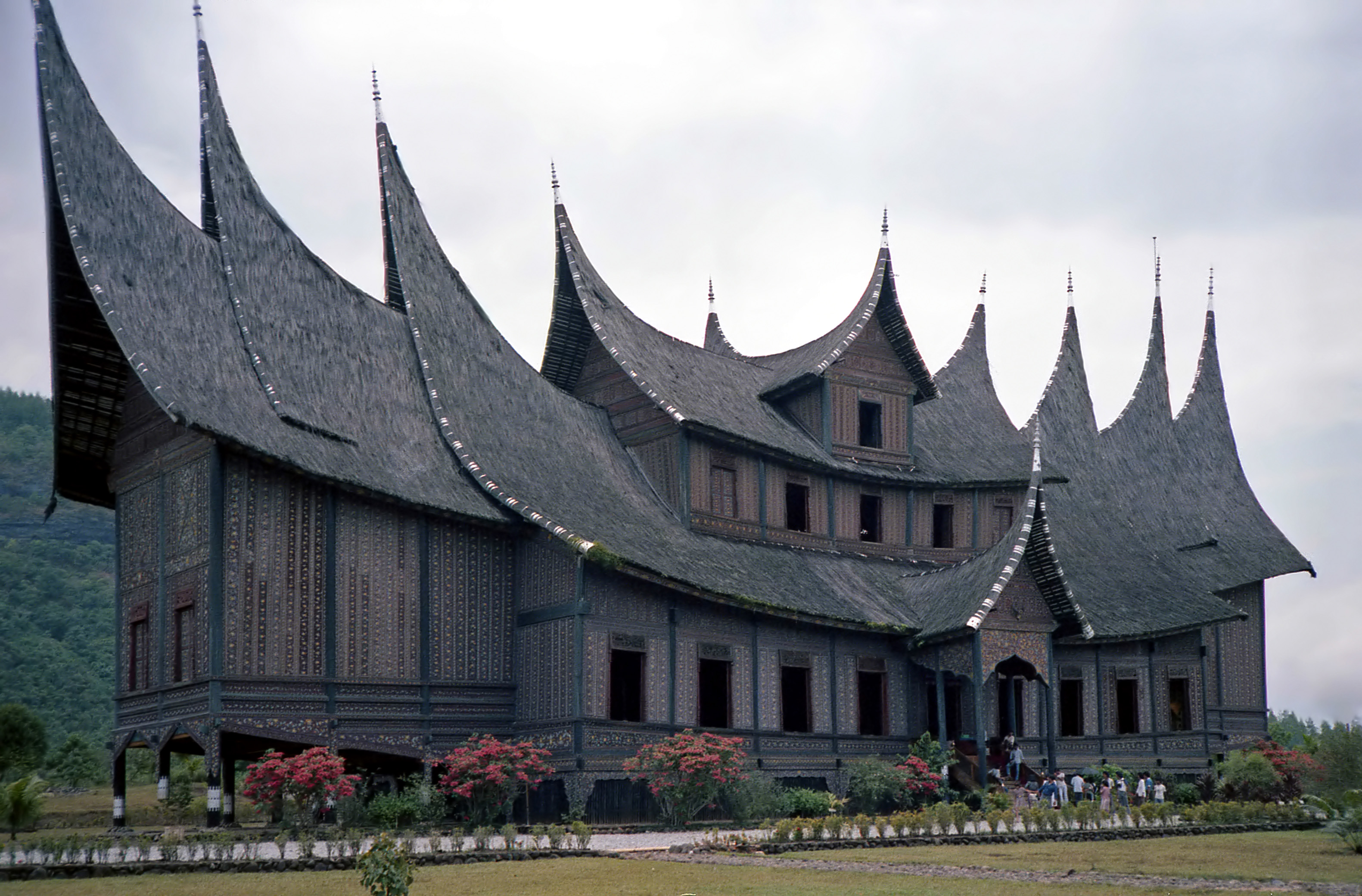|
Belimbing, West Sumatra
Belimbing (sometimes called Balimbiang) is a small village in the Minangkabau Highlands of West Sumatra, Indonesia. It is famous for its outstanding collection of vernacular architecture, including what is thought to be the oldest surviving example of a rumah gadang tuo, the traditional house of the Minangkabau people. The town is located on a back road between the market town of Batu Sangkar and Lake Singkarak. Architecture Belimbing boasts one of the biggest surviving clusters of traditional Minangkabau houses, many of which are claimed to be between two and three hundred years old. These houses feature the traditional buffalo-horn roof that is characteristic of Minangkabau architecture. Some of the houses are still occupied whilst others have been abandoned and have fallen into a state of decay. The village also features a traditional 'balai adat', where men would traditionally meet to decide village business. However the village is best known for its venerable 'rumah gadang tu ... [...More Info...] [...Related Items...] OR: [Wikipedia] [Google] [Baidu] |
Minangkabau Highlands
The Minangkabau Highlands ( id, Dataran Tinggi Minangkabau, Minang: ''Minang Darek'') is a mountainous area in the province of West Sumatra, located around three mountains—Mount Marapi, Mount Singgalang, and Mount Sago—in west-central Sumatra, Indonesia. The highlands are part of the Barisan Mountains, the largest mountain range in Sumatra. They are home to the Minangkabau people who refer them as ''Alam Minangkabau'', or "the world of Minangkabau". This area formed a kingdom known from at least the 7th century as Malayu. It is probable that wet rice cultivation evolved in the highlands long before it appeared in other parts of Sumatra, and predates significant foreign contact. Inscriptions in the area have been found from the rule of Adityavarman (1347–1375). The Dutch began exploiting the gold reserves in the highlands in the 1680s. They dominated the trade in the area, severely restricting the trade outlets between the highlands and the ports on the coast between 18 ... [...More Info...] [...Related Items...] OR: [Wikipedia] [Google] [Baidu] |
West Sumatra
West Sumatra ( id, Sumatra Barat) is a Provinces of Indonesia, province of Indonesia. It is located on the west coast of the island of Sumatra and includes the Mentawai Islands off that coast. The province has an area of , with a population of 5,534,472 at the 2020 Indonesian census, 2020 census.Badan Pusat Statistik, Jakarta, 2021. The official estimate at mid 2021 was 5,580,232.Badan Pusat Statistik, Jakarta, 2022. West Sumatra borders the Indian Ocean to the west, as well as the provinces of North Sumatra to the north, Riau to the northeast, Jambi to the southeast, and Bengkulu to the south. The province is List of regencies and cities in West Sumatra, subdivided into twelve Regency (Indonesia), regencies and seven City status in Indonesia#Kota, cities. It has relatively more cities than other provinces outside of Java, although several of them are relatively low in population compared with cities elsewhere in Indonesia. ' is the province's capital city, capital and List of Indo ... [...More Info...] [...Related Items...] OR: [Wikipedia] [Google] [Baidu] |
Indonesia
Indonesia, officially the Republic of Indonesia, is a country in Southeast Asia and Oceania between the Indian and Pacific oceans. It consists of over 17,000 islands, including Sumatra, Java, Sulawesi, and parts of Borneo and New Guinea. Indonesia is the world's largest archipelagic state and the 14th-largest country by area, at . With over 275 million people, Indonesia is the world's fourth-most populous country and the most populous Muslim-majority country. Java, the world's most populous island, is home to more than half of the country's population. Indonesia is a presidential republic with an elected legislature. It has 38 provinces, of which nine have special status. The country's capital, Jakarta, is the world's second-most populous urban area. Indonesia shares land borders with Papua New Guinea, East Timor, and the eastern part of Malaysia, as well as maritime borders with Singapore, Vietnam, Thailand, the Philippines, Australia, Palau, and India ... [...More Info...] [...Related Items...] OR: [Wikipedia] [Google] [Baidu] |
Vernacular Architecture
Vernacular architecture is building done outside any academic tradition, and without professional guidance. This category encompasses a wide range and variety of building types, with differing methods of construction, from around the world, both historical and extant, representing the majority of buildings and settlements created in pre-industrial societies. Vernacular architecture constitutes 95% of the world's built environment, as estimated in 1995 by Amos Rapoport, as measured against the small percentage of new buildings every year designed by architects and built by engineers. Vernacular architecture usually serves immediate, local needs; is constrained by the materials available in its particular region; and reflects local traditions and cultural practices. Traditionally, the study of vernacular architecture did not examine formally schooled architects, but instead that of the design skills and tradition of local builders, who were rarely given any attribution for the w ... [...More Info...] [...Related Items...] OR: [Wikipedia] [Google] [Baidu] |
Rumah Gadang Tuo , a governorate and city in Riyadh Region, Saudi Arabia
{{disambiguation ...
Rumah means "house" or "home" in the Indonesian language. It may also refer to: * Rumah Gadang, the traditional house of Minangkabau people, Indonesia * Rumah Lanting, the traditional house of Kalimantan, Indonesia * Rumah, Riyadh Rimah Governorate (sometimes pronounced as Rumah or Romah) is one of the governorates of Riyadh Province. It is located about 120 kilometers north-east of Riyadh City, and bounded on the north-east by Eastern Province, on the South by Riyadh, and ... [...More Info...] [...Related Items...] OR: [Wikipedia] [Google] [Baidu] |
Minangkabau People
Minangkabau people ( min, Urang Minang; Indonesian or Malay: ''Orang Minangkabau'' or ''Minangkabo''; Jawi: منڠكبو), also known as Minang, are an Austronesian ethnic group native to the Minangkabau Highlands of West Sumatra, Indonesia. The Minangkabau's West Sumatran homelands was the seat of the Pagaruyung Kingdom, believed by early historians to have been the cradle of the Malay race, and the location of the Padri War (1821 to 1837). Minangkabau are the ethnic majority in West Sumatra and Negeri Sembilan. Minangkabau are also a recognised minority in other parts of Indonesia as well as Malaysia, Singapore and the Netherlands. Etymology There are several etymology of the term Minangkabau. While the word "kabau" undisputedly translates to "Water Buffalo", the word "minang" is traditionally known as a pinang fruit that people usually chew along the 'Sirih' leaves. But there is also a folklore that mention that term Minangkabau (Minangkabau: ''Minang'' Jawi script: � ... [...More Info...] [...Related Items...] OR: [Wikipedia] [Google] [Baidu] |
Batu Sangkar
Batusangkar (''batu'': stone, rock, ''sangkar'': cage) is the capital of the Tanah Datar regency of West Sumatra, Indonesia. It is known as "the city of culture". History The town is near the former seat of the Minangkabau royalty established by Adityawarman in ''Pagaruyung'', represented by the reconstructed Pagaruyung Palace. A number of stones bearing inscriptions ('' prasasti'') left by Adityavarman that remain in the region are the first written records in West Sumatra. After the death of Adityawarman (1375) no more stone inscriptions were produced. Fort van der Capellen The town was known as Fort van der Capellen during colonial times, when it was a Dutch outpost established during the Padri War (1821–37). The fort was built between 1822 and 1826 and named after the Governor-General of the Dutch East Indies, Godert van der Capellen Godert Alexander Gerard Philip, Baron van der Capellen (December 15, 1778 – April 10, 1848) was a Dutch statesman from Utrecht (city), Ut ... [...More Info...] [...Related Items...] OR: [Wikipedia] [Google] [Baidu] |
Lake Singkarak
Lake Singkarak ( id, Danau Singkarak) is a lake in West Sumatra, Indonesia. It is located between the regencies of Tanah Datar and Solok Regency. It has an area of 107.8 km2, being approximately 21 km long and 7 km wide. The natural outlet for excess water is the Ombilin river which flows eastward to the Strait of Malacca. A hydroelectric project, however, has diverted most of the lake outflow to the Anai river which flows westward into the Indian Ocean near Padang. This Singkarak power station uses this water to generate power for the West Sumatra and Riau provinces. A species of fish called ''ikan bilih'' (''Mystacoleucus padangensis'') is endemic to the lake, and is harvested for human consumption. A railway line, which connects Padang and Sawahlunto-Sijunjung, skirts the length of the lake on the eastern side. See also * List of lakes of Indonesia Notes References * * * * * Singkarak Lake Singkarak ( id, Danau Singkarak) is a lake in West Sumatra, Ind ... [...More Info...] [...Related Items...] OR: [Wikipedia] [Google] [Baidu] |
Architecture Of Indonesia
The architecture of Indonesia reflects the diversity of cultural, historical and geographic influences that have shaped Indonesia as a whole. Invaders, colonizers, missionaries, merchants and traders brought cultural changes that had a profound effect on building styles and techniques. Numbers of Indonesian vernacular houses have been developed throughout the archipelago. The traditional houses and settlements of the several hundreds ethnic groups of Indonesia are extremely varied and all have their own specific history. The houses hold social significance in society and demonstrate local ingenuity in their relations to environment and spatial organisation. Traditionally, the most significant foreign influence has been Indian. However, Chinese, Arab, and European influences have also played significant roles in shaping Indonesian architecture. Religious architecture varies from indigenous forms to mosques, temples, and churches. The sultans and other rulers built palaces. T ... [...More Info...] [...Related Items...] OR: [Wikipedia] [Google] [Baidu] |






